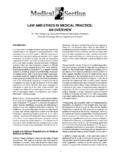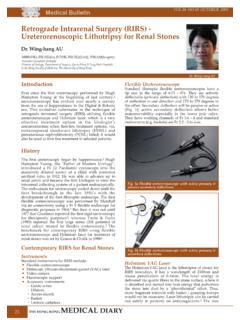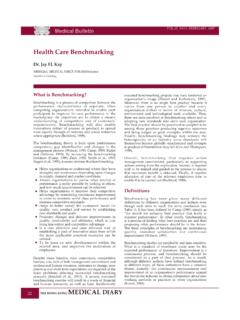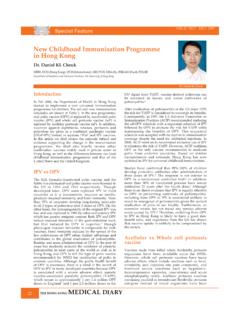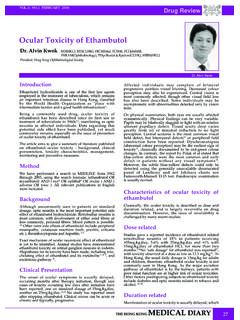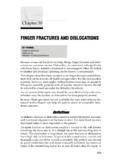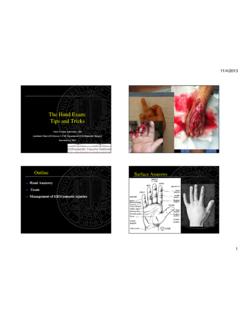Transcription of Easily Missed Hand & Wrist Injuries - fmshk.org
1 MedicalBulletin JANUARY 2010 The hand and Wrist are used in almost all sports and the hand is often the least protected part of the upper extremity, leaving it vulnerable to Injuries . Therefore, the hand is the most frequently injured part of the athlete's upper extremity. These Injuries vary widely; diagnosis is straightforward for many but not for others. When not diagnosed early and managed appropriately, these Injuries may result in long-term disabling conditions. Evaluation begins with a careful physical examination, including localisation of swelling and tenderness and functional testing of joint stability.
2 Radiographic studies are often needed. Treatment of the Injuries ranges from immobilistion to Snuff-box Pain - Scaphoid FractureOne of the most important and most often Missed carpal Injuries is a scaphoid fracture. The scaphoid is the most frequently fractured carpal bone. With a precarious blood supply of being retrograde from distal to proximal, fracture at the scaphoid waist may lead to nonunion, and has a higher chance of developing osteonecrosis in the proximal fragment. An intact scaphoid is crucial to normal Wrist function. Undiagnosed and untreated scaphoid fractures can cause chronic Wrist pain, loss of grip strength, and accelerated degenerative changes of the Wrist mechanism of fracture usually is a fall on an outstretched hand with the Wrist in hyperextension.
3 There should be no obvious deformity. The patient may feel a little discomfort, and range of motion is only slightly limited. Palpation is one of the key diagnostic tools in identifying a scaphoid fracture. Tenderness at the anatomic snuff-box is considered pathognomonic for a scaphoid fracture (figure 1). Diagnosis is difficult and should always be suspected in a typical presentation. Radiographs of the Wrist should include a scaphoid view that is anteroposterior with 30 degrees supination and ulnar deviation (figure 2). An x-ray study is usually helpful, but fractures can be Missed or misdiagnosed even with good films.
4 If radiographs are negative for fracture but a fracture is suspected clinically, the patient should be placed in a thumb spica splint. Clinical symptoms and radiographs are then rechecked in one to two weeks. Plain radiographs may not be able to show an undisplaced fracture line initially; a bone scan or computerised tomography (CT) can be helpful in arriving at the of a scaphoid fracture depends on the location and stability of the fracture. Conservative treatment for a non-displaced fracture with a thumb spica cast is acceptable. A displaced fracture is indicated for surgical fixation. Technological advances have improved union rates and accelerated the time to union.
5 Percutaneous screw fixation can provide better compression strength and rigid internal fixation, thus allowing earlier mobilisation and return to usual activities (figure 3). Easily Missed Hand & Wrist InjuriesDr. Alex KC POON Dr. Alex KC POON This article has been selected by the Editorial Board of the Hong Kong Medical Diary for participants in the CME programme of the Medical Council of Hong Kong (MCHK) to complete the following self-assessment questions in order to be awarded one CME credit under the programme upon returning the completed answer sheet to the Federation Secretariat on or before 31 January , Sports and Arthroscopic Surgery Division, Department of Orthopaedics and Traumatology, Pamela Youde Nethersole Eastern HospitalFRCSEd(Orth), FHKCOS, FHKAM (Orthopaedic Surgery)
6 Figure 1 Figure MAY 2006 MedicalBulletin JANUARY 2010 Wrist Sprain - Carpal InstabilitiesDislocations at and around the lunate are often misdiagnosed as severe Wrist sprain. When left unrecognised and untreated, these Injuries lead to a high incidence of long-term functional disability and chronic pain. Avascular necrosis of the lunate is a potential complication of lunate dislocation . Carpal instabilities represent a continuum of Wrist injury that can lead to lunate or perilunate dislocation . These generally are the result of high-energy traumas to the Wrist , with the most common mechanism being a fall on the outstretched hand with the Wrist in hyperextension and ulnar deviation.
7 Scapholunate dissociation is the first stage of carpal instability. This is also the most common and most Easily Missed type of carpal instabilities. This is characterised by widening of the scapholunate joint on the posteroanterior (PA) view (figure 5). This has been given the eponym the "Terry Thomas sign" after the British comedian with a gap between his front teeth. Standard radiographs are usually normal, so when a scapholunate ligament injury is suspected clinically, additional stress views (ulnar deviation with a clenched fist) will accentuate widening of the scapholunate joint.
8 Perilunate and lunate dislocations are progressions of the same pathologic process. The mechanism is a progressive pattern of carpal ligamentous Injuries caused by Wrist hyperextension and ulnar deviation. The dislocations may also be associated with specific bony fractures. The hallmark and defining feature of perilunate dislocation is a dislocation of the head of the capitate from the distal surface of the lunate (figure 6). The defining feature of lunate dislocation is disruption of the association between the lunate and the lunate fossa of the distal radius (figure 7).
9 Hypothenar Eminence Pain - Hook of Hamate Fracture?The hamate is the medial bone in the distal row of carpal bones, located beneath the base of the little finger. Fractures at the hook of the hamate most often are a diagnostic problem in patients who sustain a direct blow against the hamate from the handle of a tennis racket or golf club during an unbalanced swing. Radiation of pain to the dorsum of the hand is common, and the patient will have point tenderness over the hook of the hamate, located at the ulnar aspect of the palm near the base of the fourth metacarpal.
10 The mechanism of injury can provide a clue to the diagnosis, but the injury could also be a stress injury with a less obvious initiating diagnosis is often Missed or delayed because the x-ray views of the Wrist that are usually taken do not demonstrate the lesion. In suspected cases, a carpal tunnel x-ray view or a CT scan may be needed to make the diagnosis of a hook of the hamate fracture (figure 4). Once the diagnosis is confirmed, a trial of casting for 4 to 6 weeks is indicated if symptoms are relieved by simple immobilisation. Operative excision of the fracture fragment is indicated to relieve pain and improve grip strength if the patient remains symptomatic after 6 to 8 weeks of cast 3 Figure 5 Figure 4 MedicalBulletin JANUARY 2010 Figure 6 Figure 7 Figure 8 The patient may have diffuse pain on palpation that is difficult to distinguish from other causes of Wrist pain.


